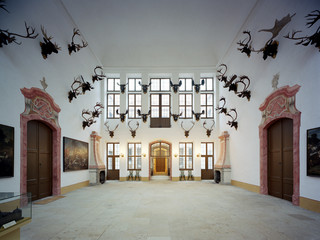Duke Maurice of Saxony had a hunting lodge built in the Renaissance style in 1542 on a granite dome in Friedewald Forest that was rich in wildlife. Soon the castle, which later was named after him, was the center of Saxon hunting. The Castle Chapel was built in 1661 under the auspices of Elector John George II and consecrated Catholic during the coronation of Augustus the Strong to become the King of Poland. To this day, regular services are held in that chapel.
But Elector Augustus the Strong had yet other plans with Moritzburg Castle. In 1723, major works began to convert it from a Renaissance building into a Baroque hunting and pleasure palace. Here, the Elector wanted to celebrate his excessive feasts and hunts. His dream was to build a "Temple of Diana", surrounded by exotic animal enclosures with lions, cheetahs and European bisons. Opulent banquets or naval battles staged on the castle pond were also part of this. Architect Matthaeus Daniel Poeppelmann was commissioned with the project. He had further ponds and animal enclosures created – the pheasant-breeding place east of the castle is testimony to this fact. The best Saxon craftsmen and artists collaborated in the providing the interior in the seven halls and more than 200 rooms. The entire piece of art is of great structural clarity and harmony with the landscape. After the death of Augustus the Strong, the conversion remained unfinished.
As late as in 1800 only, the area of the castle was further integrated into the landscape by a great-grandson of the Elector. The Little Pheasant Castle, the harbor and the lighthouse pier were built at the Lower Great Lake Baernsdorf. From 1933 on, Moritzburg Castle was used as a residence by Wettin Prince Ernst Heinrich of Saxony until 1945, when the Wettins were expropriated. Some of their most precious art treasures were buried in the castle park by Prince Ernst Heinrich of Saxony and his sons, but for a few exceptions, these were detected by the Soviet troops and carried off. Only in 1996, several boxes with jewels and gold ornaments on the outside were unearthed by amateur archaeologists and identified as Wettin treasure. Today, Moritzburg is a renowned meeting place for lovers of Saxon Baroque and Meissen porcelain.






